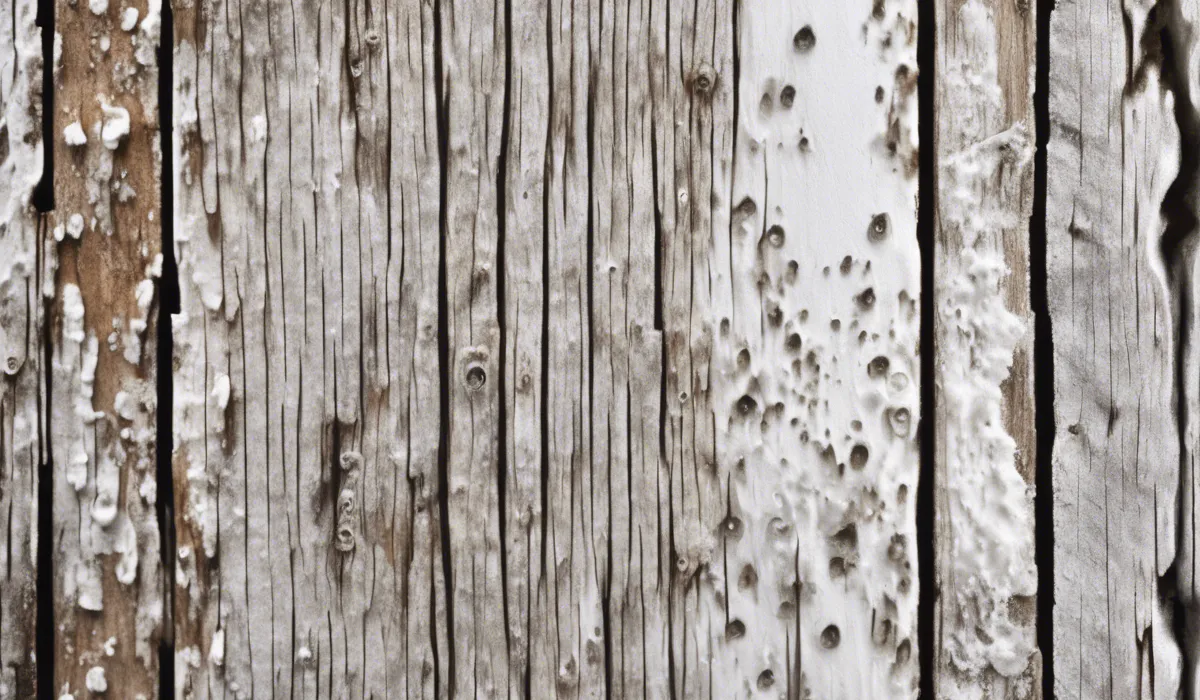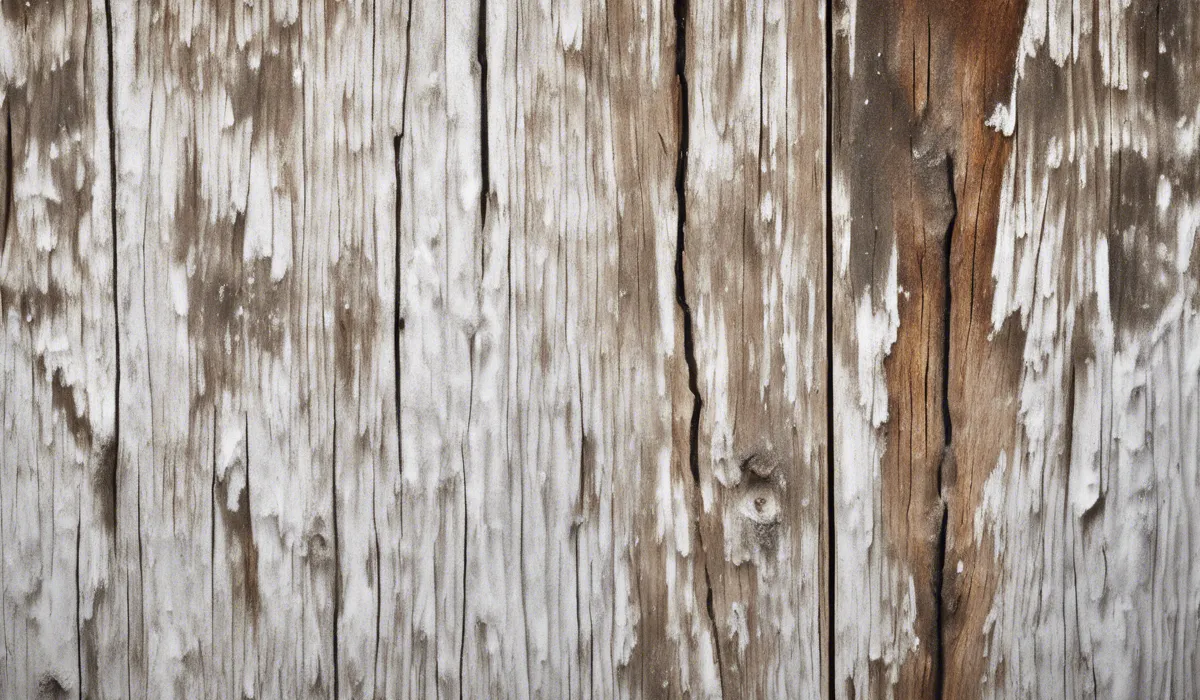Yes, white mold on wood can be dangerous as it suggests underlying moisture issues and can lead to structural damage. It may also cause allergic reactions or respiratory problems in sensitive individuals. Immediate remediation is recommended to prevent health risks and property damage.
Understanding White Mold on Wood

What Is White Mold?
White mold is a type of fungus that thrives in damp conditions. It appears as a powdery or fluffy substance and can sometimes look like a thin, white, thread-like layer on wood surfaces.
Unlike other molds that are dark in color, white mold is not always easy to spot, especially on light-colored wood.
It can gradually weaken wood by breaking down its fibers, a process that can lead to serious structural problems over time.
Commonly Affected Wood Types
White mold can grow on a variety of wood types. Softwoods like pine and spruce, commonly used in building construction, are particularly susceptible due to their porous nature.
Hardwoods like oak and maple can also be affected, but typically have more resistance to mold growth due to their density.
Growth-Inducing Conditions
Moisture is the main factor that encourages mold growth. White mold on wood often indicates a problem with water damage, high humidity, or condensation.
Poor ventilation in areas like basements and attics provides the perfect environment for mold to thrive.
Leaks, flooding, or dampness can also contribute to the problem, creating ideal conditions for white mold to spread.
Identifying White Mold Versus Other Discolorations
It’s crucial to differentiate between white mold and other wood discolorations such as mineral deposits or efflorescence, which are harmless.
White mold feels soft and can smear when touched, whereas mineral deposits are hard and crystalline. An expert can help confirm the presence of white mold through testing if you are unsure.
Health Implications of White Mold Exposure

Effects of Mold on Health
Inhaling or touching white mold spores can cause allergic reactions such as sneezing, itching, watery eyes, and skin rashes.
Long-term exposure may lead to more serious respiratory issues. Although not all molds are toxic, the presence of any mold in the home can negatively impact indoor air quality and health.
High-Risk Groups
People with weakened immune systems, allergies, asthma, or other respiratory conditions are at a higher risk for health problems from mold exposure.
Children and the elderly are also more susceptible to the effects of mold and may experience symptoms more acutely.
Comparison with Black Mold and Other Fungi
Black mold, known as Stachybotrys chartarum, is often talked about as being particularly dangerous due to its association with mycotoxins.
However, all molds, including white mold, can pose health risks and should be treated with caution. It is the amount and duration of exposure that largely determine the potential for health issues.
Expert Opinions on Mold
Health organizations like the Centers for Disease Control and Prevention (CDC) and the Environmental Protection Agency (EPA) advise addressing mold issues promptly.
These experts agree that any mold growth indoors should be removed as it can contribute to poor health outcomes for occupants.
Handling and Preventing White Mold on Wood

Safe Mold Removal Steps
To remove white mold from wood, start by wearing protective gear like gloves, goggles, and a mask.
Isolate the affected area to prevent spores from spreading. Use a soft brush to gently remove loose mold from the surface.
Clean the wood with a mixture of water and a mild detergent, then dry the area thoroughly.
For persistent mold, a solution of water and vinegar or a commercial mold remover may be necessary. Ensure the space is well-ventilated during the cleaning process.
Recommended Protective Equipment and Cleaners
Protective equipment is essential to safeguard your health during mold removal. Use an N-95 respirator mask, long gloves, and eye protection.
Choose cleaning agents that are designed for mold removal but are safe for the type of wood you are treating. Non-toxic options like vinegar can be effective, but for larger infestations, stronger fungicides may be needed.
Prevention Strategies for Mold on Wood
To prevent mold from returning, control moisture levels by using dehumidifiers and maintaining good air circulation.
Fix leaks and dry wet areas promptly. Seal wood surfaces with mold-resistant paint or sealants. Keep indoor humidity levels between 30-50% to deter mold growth.
Importance of Moisture Control and Regular Checks
Consistent moisture control is the key to preventing mold. Regularly inspect your home for signs of water damage or mold, paying close attention to hidden areas like crawlspaces and behind furniture.
Ensure your home has adequate ventilation, especially in areas prone to moisture like bathrooms and kitchens. Addressing these factors will help maintain a mold-free environment.
FAQs About White Mold on Wood
Is white mold on wood harmful to humans?
Yes, white mold on wood can be harmful as it may cause allergic reactions or respiratory issues, especially in sensitive individuals.
Can white mold on wood cause structural damage?
Yes, white mold indicates moisture problems which can lead to structural damage if not addressed promptly.
Should I remove white mold on wood immediately?
Immediate remediation is recommended to prevent further health risks and damage to the property.
What are the health risks of white mold on wood?
Health risks include allergic reactions and respiratory problems, such as coughing, wheezing, or asthma attacks.
How can I prevent white mold from growing on wood?
Prevent white mold by controlling humidity levels, ensuring proper ventilation, and promptly repairing any water leaks.
Final Thoughts
White mold on wood is a cause for concern, signaling moisture problems that can compromise structural integrity.
It poses potential health hazards, especially to those with allergies or respiratory issues. Prompt action to address and eradicate this mold is crucial to safeguard both the well-being of occupants and the condition of the property.
